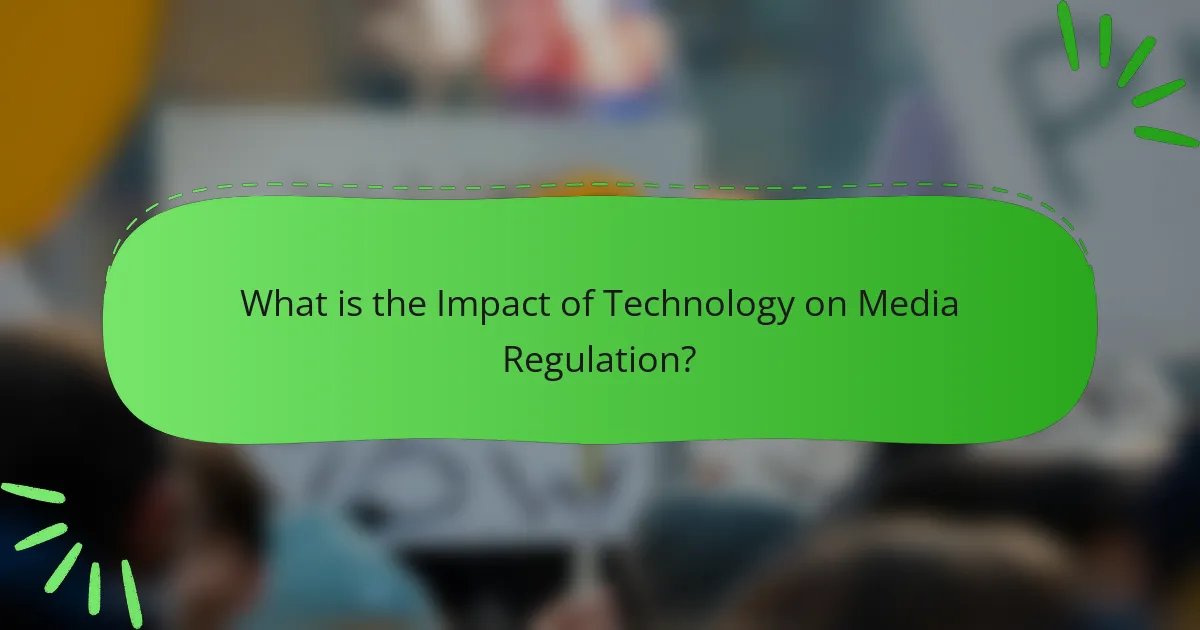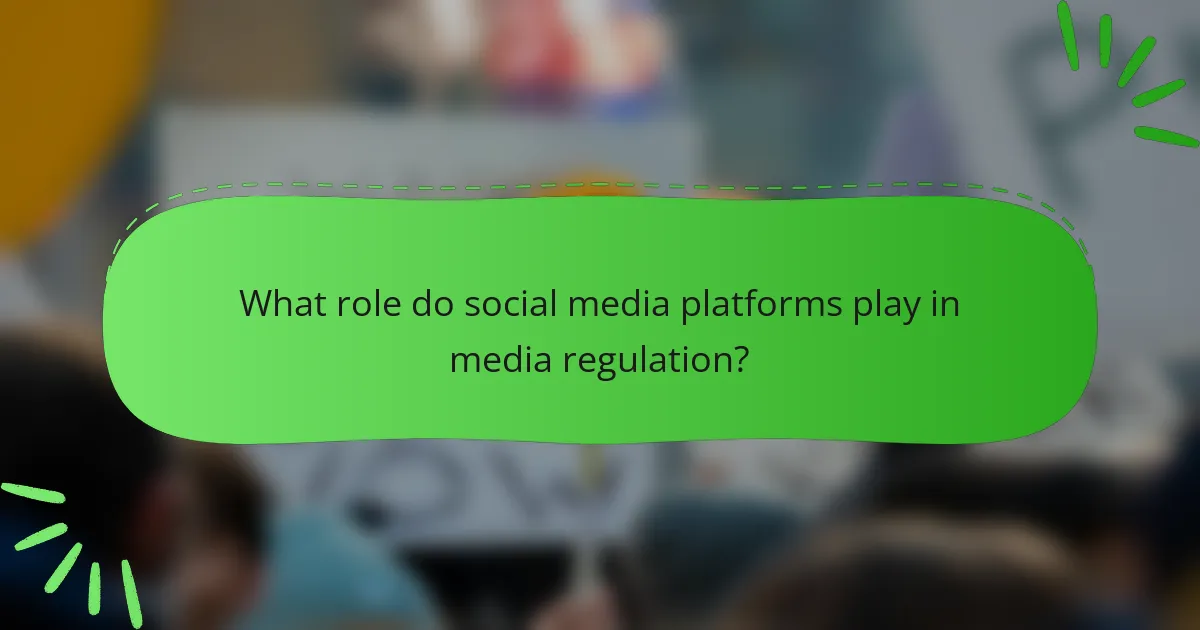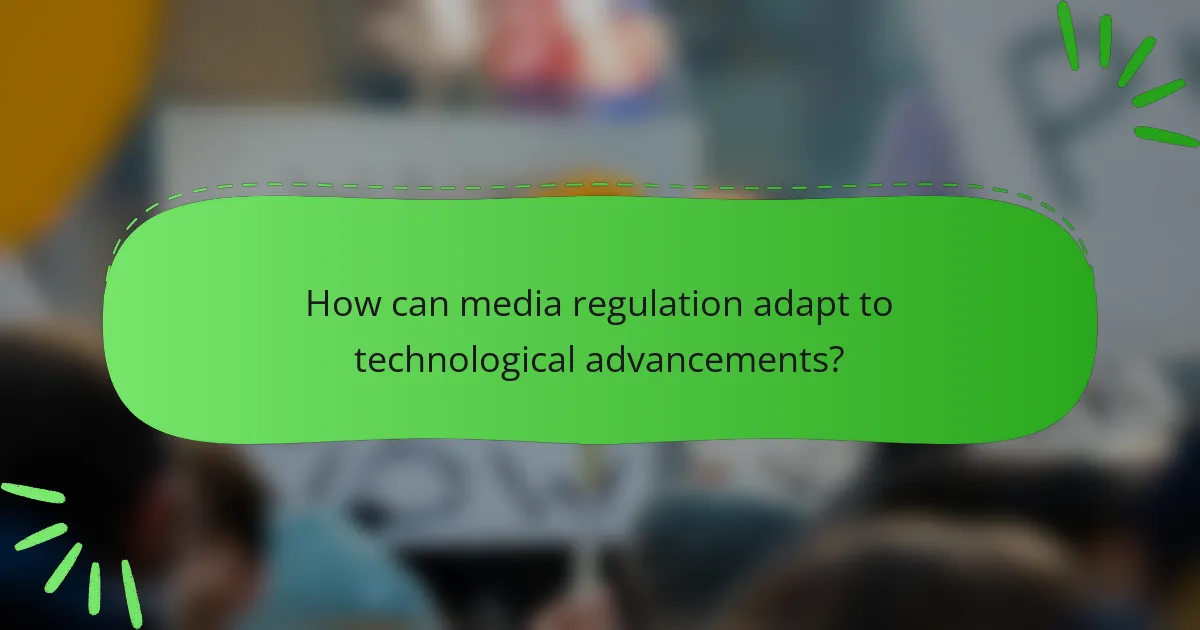The article examines the impact of technology on media regulation, focusing on how advancements in digital platforms affect content production, distribution, and consumption. It highlights the challenges faced by regulatory bodies in enforcing traditional regulations, particularly regarding the rapid dissemination of information on social media and the amplification of misinformation by algorithms. The discussion includes the significance of adaptive regulatory frameworks, exemplified by the European Union’s Digital Services Act, and emphasizes the need for collaboration between regulators and technology companies to address issues such as harmful content, misinformation, and privacy. Overall, the article underscores the importance of proactive approaches in media regulation to keep pace with technological changes.

What is the Impact of Technology on Media Regulation?
Technology significantly influences media regulation by changing how content is produced, distributed, and consumed. The rise of digital platforms has led to new challenges in enforcing traditional regulations. For example, social media allows instant dissemination of information, often bypassing regulatory oversight. This creates difficulties in monitoring harmful content. Additionally, algorithms used by platforms can amplify misinformation. Regulatory bodies struggle to keep pace with rapid technological advancements. Studies show that countries with adaptive regulatory frameworks are better at addressing these challenges. The European Union’s Digital Services Act exemplifies proactive regulation in response to technological changes.
How has technology transformed media regulation practices?
Technology has significantly transformed media regulation practices. Digital platforms enable real-time monitoring of content. Algorithms can detect harmful or illegal material quickly. This enhances compliance with regulations like the GDPR. Additionally, technology facilitates user reporting mechanisms. Users can flag inappropriate content, increasing accountability. Data analytics provide insights into media consumption patterns. This helps regulators understand trends and adapt policies. Overall, technology streamlines regulatory processes and improves enforcement efficiency.
What are the key technological innovations influencing media regulation?
Key technological innovations influencing media regulation include artificial intelligence, blockchain technology, and data analytics. Artificial intelligence enhances content moderation and compliance monitoring. It enables automated detection of harmful content and copyright infringement. Blockchain technology provides transparency in content ownership and distribution. It helps in verifying the authenticity of media sources. Data analytics offers insights into audience behavior and content effectiveness. This information aids regulators in making informed decisions. These innovations collectively reshape how media is governed and ensure adherence to regulations.
How do these innovations alter regulatory frameworks?
Innovations in technology significantly alter regulatory frameworks by necessitating updates to existing laws. These changes often arise due to the emergence of new media platforms and distribution methods. For instance, the rise of streaming services has led to new regulations concerning content licensing and consumer protection. Additionally, advancements in data analytics require regulations on data privacy and usage. Regulatory bodies must adapt to address challenges such as misinformation and digital advertising practices. The rapid pace of innovation often outstrips the ability of regulators to keep up. This can result in gaps in regulation that may lead to consumer harm or unfair market practices. Therefore, ongoing dialogue between innovators and regulators is essential for effective governance.
What challenges does technology pose to media regulation?
Technology presents significant challenges to media regulation. The rapid pace of technological advancement outstrips existing regulatory frameworks. Traditional media regulations often do not apply to digital platforms. This creates gaps in oversight and enforcement. The rise of social media complicates content moderation and accountability. Algorithms can amplify misinformation and harmful content. Additionally, global nature of the internet makes jurisdiction enforcement difficult. These factors hinder effective regulation and protect consumers.
What are the primary concerns regarding privacy and data protection?
The primary concerns regarding privacy and data protection include unauthorized data access, data breaches, and misuse of personal information. Unauthorized access occurs when individuals or organizations gain access to sensitive data without permission. Data breaches can lead to the exposure of personal data, affecting millions of users. Misuse of personal information often involves companies selling or sharing data without user consent. According to a 2021 report by the Identity Theft Resource Center, data breaches in the U.S. reached a record high, with over 1,800 incidents reported. This highlights the growing risk to personal privacy and the need for stronger data protection measures.
How does misinformation complicate media regulation efforts?
Misinformation complicates media regulation efforts by creating challenges in identifying and addressing false content. Regulators struggle to differentiate between legitimate information and misleading claims. The rapid spread of misinformation on digital platforms further complicates timely responses. Traditional regulatory frameworks often lack the agility to adapt to new technologies. This results in gaps in enforcement and accountability. Additionally, misinformation can erode public trust in media, making regulation more contentious. Studies indicate that misinformation can significantly influence public opinion and behavior, complicating regulatory objectives. Overall, the dynamic nature of misinformation presents ongoing challenges for effective media regulation.

What role do social media platforms play in media regulation?
Social media platforms play a significant role in media regulation by influencing content dissemination and user engagement. They serve as gatekeepers, determining what information is shared and how it is moderated. Their algorithms can amplify or suppress content based on user interactions. This power raises questions about accountability and transparency in content regulation. For instance, platforms like Facebook and Twitter have implemented community standards to manage harmful content. These standards aim to protect users while balancing free speech. Additionally, social media companies face pressure from governments to regulate misinformation and hate speech. This dynamic shapes the broader media landscape and regulatory environment.
How do social media platforms influence regulatory policies?
Social media platforms influence regulatory policies by shaping public discourse and political agendas. They provide a space for users to express opinions and mobilize support on various issues. This user-generated content often attracts the attention of policymakers. As a result, social media can pressure governments to address specific concerns, such as privacy, misinformation, and hate speech. For instance, the Cambridge Analytica scandal prompted discussions about data privacy regulations. Furthermore, social media companies often engage with regulators to influence policy outcomes. They may lobby for favorable regulations or provide data to support their positions. These interactions can lead to new laws or amendments that reflect the interests of both users and the platforms themselves.
What are the implications of user-generated content on regulation?
User-generated content significantly impacts regulation by creating challenges for content moderation and accountability. Regulators face difficulties in enforcing existing laws due to the sheer volume of user-generated content. This content often lacks clear authorship, complicating the identification of responsible parties for harmful or illegal material.
Moreover, user-generated content can lead to the spread of misinformation, prompting calls for stricter regulations to protect public interest. For instance, the rise of deepfakes has raised concerns about authenticity and trust in media.
Regulatory bodies must adapt to these challenges by developing new frameworks that balance freedom of expression with the need for safety and accountability. Countries like Germany have implemented laws such as the NetzDG, requiring platforms to remove hate speech promptly.
These developments indicate a shift in regulatory approaches, emphasizing the need for collaboration between platforms, users, and regulators to ensure effective oversight.
How do platforms address compliance with existing regulations?
Platforms address compliance with existing regulations through various strategies. They implement robust content moderation systems to ensure adherence to legal standards. This includes automated tools and human review processes. Platforms also maintain transparency by publishing regular compliance reports. These reports detail actions taken to align with regulations. Furthermore, they engage in consultations with regulatory bodies. This helps platforms understand evolving legal requirements. Training programs for staff on compliance issues are also common. These initiatives enhance internal awareness and accountability. Overall, these measures collectively support regulatory compliance.
What are the ethical considerations in regulating technology in media?
Ethical considerations in regulating technology in media include privacy, misinformation, and access. Privacy involves protecting user data from unauthorized use. Regulations must ensure that personal information is secured and used ethically. Misinformation poses risks to public trust and safety. Regulations should aim to prevent the spread of false information while balancing free speech. Access refers to ensuring equitable technology availability. Regulations should promote inclusivity and prevent digital divides. These considerations are critical for fostering a responsible media environment.
How do ethical dilemmas affect decision-making in media regulation?
Ethical dilemmas significantly influence decision-making in media regulation. They create challenges when balancing freedom of expression with public interest. Regulators often face conflicting values, such as protecting privacy versus ensuring transparency. These dilemmas can lead to inconsistent policies and enforcement. For example, the debate over misinformation requires regulators to weigh truth against censorship. Ethical frameworks guide decision-making processes, but they can vary widely among stakeholders. As technology evolves, new ethical concerns emerge, complicating regulatory responses. Ultimately, ethical dilemmas shape the landscape of media regulation and its effectiveness.
What frameworks exist to guide ethical media regulation?
Several frameworks exist to guide ethical media regulation. The Council of Europe’s Recommendation on Media and Communication Governance emphasizes transparency and accountability. The UNESCO Media Development Indicators provide a comprehensive framework for assessing media systems. The International Federation of Journalists outlines ethical standards for journalism, promoting integrity and public trust. The European Union’s Audiovisual Media Services Directive sets rules for audiovisual content, ensuring consumer protection. Each framework addresses specific aspects of media ethics and regulation, promoting responsible practices in the digital age.

How can media regulation adapt to technological advancements?
Media regulation can adapt to technological advancements by implementing flexible frameworks. These frameworks should allow for rapid updates in response to emerging technologies. For instance, regulations can incorporate guidelines for digital platforms and social media. This ensures that they address issues like misinformation and privacy. Additionally, collaboration between regulators and tech companies can foster innovation. It can lead to the development of best practices that benefit both sectors. Historical examples show that adaptive regulations can effectively manage challenges posed by new technologies. The evolution of telecommunications regulation illustrates this adaptability. Overall, proactive approaches enable media regulation to keep pace with technological change.
What strategies can regulators employ to keep pace with technology?
Regulators can employ adaptive regulatory frameworks to keep pace with technology. These frameworks allow for flexibility in response to rapid technological advancements. Regulators can also engage in proactive stakeholder consultations. This ensures that diverse perspectives are considered in the regulatory process. Implementing sandbox environments for testing new technologies can facilitate innovation while managing risks. Continuous education and training for regulators on emerging technologies is essential. This equips them to understand and address new challenges effectively. Collaboration with technology experts can enhance regulatory effectiveness. Using data-driven approaches can improve decision-making and responsiveness to technological changes.
How can collaboration between stakeholders enhance regulatory effectiveness?
Collaboration between stakeholders enhances regulatory effectiveness by fostering shared knowledge and resources. When stakeholders, such as government agencies, industry players, and civil society, work together, they can identify common goals. This collective approach leads to more comprehensive regulations that consider diverse perspectives. For example, the Federal Communications Commission (FCC) collaborates with tech companies to address emerging issues in media regulation. Such partnerships can result in more informed decision-making and quicker responses to technological advancements. Additionally, stakeholder collaboration promotes transparency and accountability, building trust among the public and regulators. This trust is crucial for the successful implementation of regulations in a rapidly evolving media landscape.
What role does public feedback play in shaping regulatory approaches?
Public feedback plays a crucial role in shaping regulatory approaches. It allows regulators to understand the concerns and needs of the community. This feedback can influence policy decisions and lead to more effective regulations. For instance, public consultations often precede major regulatory changes. These consultations gather insights from various stakeholders. The information collected can highlight potential issues or benefits of proposed regulations. Furthermore, studies show that regulations informed by public input tend to gain higher acceptance. Such acceptance can facilitate smoother implementation and compliance. Overall, public feedback ensures that regulatory frameworks are responsive and relevant to societal needs.
What best practices should regulators follow in the digital age?
Regulators should prioritize transparency, accountability, and adaptability in the digital age. Transparency involves clear communication about regulatory processes and decisions. This builds trust with the public and stakeholders. Accountability requires mechanisms for holding regulators responsible for their actions. This can include public reporting and independent audits. Adaptability is essential due to the rapid pace of technological change. Regulators must be willing to update policies as new technologies emerge. Studies show that agile regulatory frameworks enhance effectiveness in managing digital platforms. For example, the European Union’s General Data Protection Regulation (GDPR) illustrates proactive adaptation to digital privacy concerns.
How can regulators ensure transparency and accountability?
Regulators can ensure transparency and accountability by implementing clear communication protocols. They should regularly publish reports detailing their activities and decision-making processes. Engaging with the public through consultations enhances trust. Utilizing technology for real-time data sharing improves access to information. For instance, online platforms can display regulatory actions and outcomes. Independent audits can verify compliance with established standards. Additionally, establishing whistleblower protections encourages reporting of misconduct. These measures collectively foster a culture of openness within regulatory bodies.
What measures can be taken to foster innovation while ensuring compliance?
To foster innovation while ensuring compliance, organizations can implement a structured framework that encourages creativity within regulatory boundaries. This framework should include clear guidelines that define compliance requirements alongside innovation goals. Regular training sessions can help employees understand both the regulatory landscape and innovative practices. Collaboration with legal teams can ensure that innovative ideas are evaluated for compliance early in the development process. Additionally, adopting agile methodologies can allow for rapid iteration while maintaining adherence to regulations. Implementing feedback loops with stakeholders can also help identify compliance risks without stifling innovation. Companies that balance these measures can enhance their ability to innovate while meeting regulatory standards.
The primary entity of this article is the impact of technology on media regulation. It examines how technological advancements, such as artificial intelligence and blockchain, are reshaping media regulation practices, presenting both innovations and challenges. Key topics include the transformation of regulatory frameworks, the role of social media platforms in content dissemination, and the ethical considerations surrounding privacy and misinformation. The article also highlights the necessity for adaptive regulatory approaches to effectively manage the rapid changes in the media landscape and ensure compliance while fostering innovation.